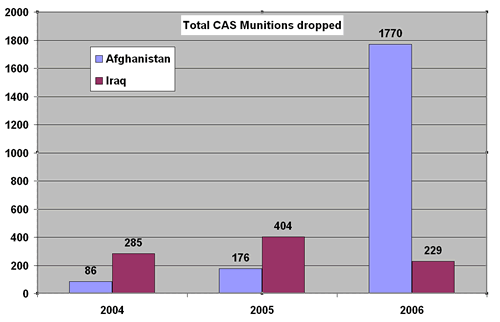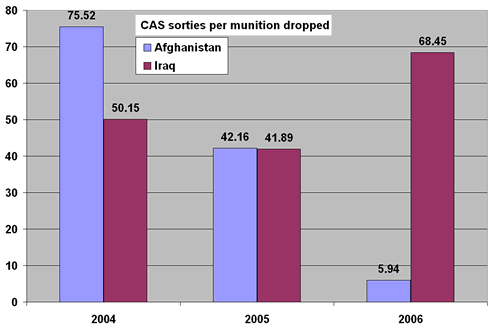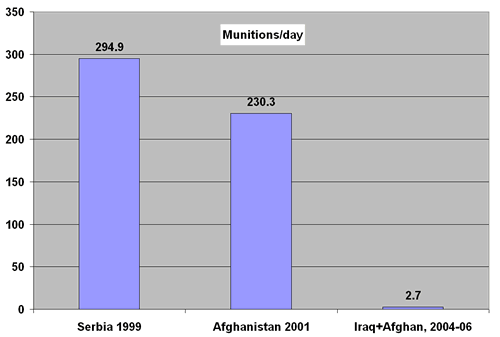April 20, 2007
Running from the past
I agree. This should have been a bigger story in Canada than it was.
April 16, 2007
Casualties in Afghanistan: update
More on the fatalities in Afghanistan in 2006, thanks to Human Rights Watch. According to their figures, in 2006, Coalition and NATO forces killed at least 230 civilians. Insurgents, through bombings and assassinations, killed at least 669.
These are obviously somewhat different from the figures Haroon Siddiqui and others have been given to Canadians (see posts below). They are also consistent with the number of bombs dropped on Afghanistan last year, which as suggested below could not have resulted in civilian fatalities due to NATO action above the low hundreds (the remainder of the NATO-induced fatalities are almost certainly mistaken roadside shootings, etc.)
Note also that, given that both the UN and AP independently estimated that total killings in Afghanistan in 2006 were in the 4,000 range, that means most of the remaining 3,000-odd difference in the two fatality stats (assuming one isn't counting the relatively small number of Western fatalities) must have been armed personnel, on either the government or insurgent side.
This is really the big difference with Iraq. In Afghanistan, the rates of killing in 2006 were still relatively low (around 13 per 100,000 population, at least an order of magnitude less than in Iraq), and regionally confined. Three-quarters of the deaths are of soldiers, and only a quarter of civilians. Of the civilians, three-quarters are the result of either indiscriminate or targeted terror attacks aimed at splitting the government from its people (as opposed to Iraq's inter-ethnic strife). Were any of those facts true in Iraq, the American situation there could be very different.
April 13, 2007
Statistics: close-air support in Iraq and Afghanistan, 2004-06
A little known fact about the use of airpower in both Iraq and Afghanistan is how few munitions are actually being dropped these days.
CENTAF (Central Command Air Forces) have regularly released daily and weekly figures on Close Air Support (CAS) sorties, and munitions dropped, for several years. The most recent is here*. These are missions carried out by American and allied air force jets, over both Iraq and Afghanistan. They do not include helicopter missions, including attack helicopters. The munitions counts also do not include engagements with cannon, or unguided air-to-surface rockets. And obviously artillery engagements are not tallied here either. This is just the bombs and guided missiles dropped or launched from military aircraft.
Still, that's a pretty big number, right? How many bombs do you think have been dropped on Iraq and Afghanistan in the last three years?
I'll save you the adding of over 1,000 daily summaries: would the answer 2,950 surprise you at all? Because that's what it is.
Here's the chart:

As you can see, over half of the total munitions that were expended by Coalition air forces in the last three years were over Afghanistan in 2006. The other weapons drops have been remarkably limited. Almost all of these munitions would have been precision weapons, either GPS- or laser-guided, dropped from a combination of B-1B Lancer bombers and various air force and naval-based fast jets.
What's perhaps most remarkable is the number of CAS sorties that are being launched for every drop of one munition. To clarify, a CAS sortie is counted every time a plane takes off with ground attack weapons loaded, either to loiter to wait for a target, or to deliver against a specific objective. A total of 71,237 CAS sorties have been launched by Coalition air forces in the 2004-06 period. About a third of these were over Afghanistan, and the remainder over Iraq. Many of these would have engaged with other weapons like cannon, as mentioned above. But the number of missions, relative to the number of actual large munitions dropped, is revealing:

Now assume for argument's sake that each sortie that dropped a munition dropped only one. (In actual fact, of course, each B-1B sortie can potentially launch many more than that**.) That would mean that, at a minimum, in both theatres of war over the last three years, over 40 attack planes have gone out fully loaded and returned fully loaded, for every bomb dropped. The exception was Afghanistan in 2006 where, again assuming one bomb per plane, about one in six sorties found a target. Once one factors in the number of bombs that could be carried and dropped by different planes, those numbers would actually be much higher.
The military doesn't seem overly concerned about this ratio being a failing of any kind. Indeed, the troops on the ground probably appreciate having the bombers on call regardless of whether they are needed. However, it certainly does indicate that neither Afghanistan nor Iraq have been particularly "target-rich" for the air forces involved.
There's lots of reasons a plane would not drop a bomb, even if it had a potential target in mind, as well, ranging from mechanical errors, to avoiding friendly fire possibilities, to the target being taken out by other means, such as the local artillery unit. Legal and other targetting issues are also no doubt playing a factor.
How do these numbers compare to other bomb-dropping rates, historically? Well, in both Vietnam and World War Two, U.S. air forces combined dropped an average of over 4,000 munitions per day, outstripping the combined Iraq/Afghanistan total for the past three years by a significant total, but that's probably not a fair comparison. Sticking to the precision era, one comes up with figures like these:

Recall that both these air wars were criticized at the time for being rather desultory, compared to, say, the 1991 Iraq war. Learned military commentators said in both cases, up to the point both wars ended favourably, that air power was not being used in sufficient quantity, since only 300-odd munitions were being dropped per day on a country the size of Serbia/Afghanistan. Well, right now Coalition forces are dropping roughly 1 per cent of that on Afghanistan and Iraq combined each day.
Which is not to argue for more bombing. Especially in Iraq, this does not appear to be a war which more bombs would help. However, it's probably worth keeping in perspective.
As mentioned here previously, aerial weapons in the precision era seem to kill civilians, as opposed to their hostile presumed targets, at a rate of about 1 civilian for every 10 munitions dropped, no matter how careful or careless the launchers are. The exact ratios, as near as historians can determine, were about 0.02 unintended fatalities per weapon in Kosovo, and about 0.07 in Afghanistan.
If one were to cross-reference a similar ratio with the numbers of bombs dropped in Iraq and Afghanistan over the last three years, even with a liberal error bar one would come up in each case with a total number of civilian fatalities due to bombing in each country in at most the low hundreds: far fewer than have been killed, for instance, by insurgent suicide bombers in both countries. This does not mean that Allied forces are not accidentally killing larger numbers of civilians in other ways: attack helicopters, artillery, small arms fire at checkpoints, all must be taking a regrettable if unintended toll, as well. But it does suggest that the aerial contribution to the civilian death tolls in Iraq and Afghanistan in the last three years cannot be a major component of, say, the 4,000 total Afghan deaths reported by the UN and Associated Press last year, or the 600,000 excess deaths in Iraq since 2003 recently estimated by researchers in the Lancet.
*So, for instance, on April 4 of this year, there were 31 close-air support missions over Afghanistan, and 55 over Iraq, in which a total of one plane (an RAF Harrier dropping a laser-guided bomb in Afghanistan) was the only engagement that used a munition.
**In Afghanistan in 2001, the strategic bombers of the 28th Air Expeditionary Wing, predominantly B-1Bs, dropped an average of 17.7 munitions per sortie.
Haroon Siddiqui: dishonest on casualties
Haroon Siddiqui in the Star today:
"The vulnerability of the Afghans is reinforced by NATO air bombings, 2,000 last year, which killed about 4,000 people."
This sentance is fundamentally dishonest. The 4,000 figure comes from the UN and Associated Press aggregate fatality counts for 2006, which nearly agree with each other. As discussed here, that estimate was of all deaths in Afghanistan from the war, not just from bombings, including insurgent attacks. A reasonable estimate is that over 2,000 of those were deaths of either Afghan police or military personnel or insurgents, and the majority of the remainder against civilians were from insurgent attacks, as Human Rights Watch had concluded previously. (Suicide bombings alone killed over 200 civilians.)
The bombings number he uses, meanwhile, relates to munitions dropped: 1,770 by Central Command figures in 2006. Now, historically, air forces have never seen the average number of civilian deaths per munition go much greater than or much lower than about 1 civilian death per 10 munitions:
*Afghanistan in 2002 saw 17,500 weapons dropped, about 10 times this number, and is believed to have killed about 1,300 civilians.
*Kosovo saw 23,000 munitions dropped, and about 500 civilians killed.
*The 1991 Gulf War saw 250,000 munitions delivered, and about 3,200 civilians killed.
One might argue, of course, that an insurgency increases the dispersal of targets among the civilian population, which might change this ratio upward, but most of the NATO air attacks in 2006 were in remote rather than urban areas, which would tend to act on the statistics in the other way.
It would therefore be at least a historically grounded hypothesis, without reference to the media coverage, to argue that NATO air attacks must have inevitably killed approximately 200 Afghan civilians in 2006 (+/-100). Two hundred too many, certainly. But even if you double it to be safe, Siddiqui is still almost certainly lying by an order of magnitude.
PS: Printing the allegation that Canadian troops are acting "with racist disregard" in Afghanistan, without substantiation of any kind (other than the non-statistics above) is a calumny that one would once have hoped would be beneath Canada's largest-circulation newspaper, as well.
It would be much easier to handle the principled opposition to the Canadian military involvement in Afghanistan if it could once in a while act as it it were principled.
UPDATE: You know, Opposition defence critics like the NDP's Dawn Black or the Liberals' Denis Coderre would not be so derided by the pro-military crowd if they, you know, once in a while, took on the excesses of anti-military press hyenas like Siddiqui and Robert Fife with a principled letter to the editor, or something. The fact they've never, ever done that, no matter what the antiwar talking heads say, speaks volumes about their own integrity.
April 12, 2007
Worst. Magazine Blog. Ever.
I'm sorry, but someone has to say it. The new blog system that Paul Wells is on is truly awful. Why is "advansis" in all the URLs? Is that meant to be stealth branding of some kind? Why is the link to Wells' front page a string?
Maclean's has perhaps the pre-eminent Canadian journalist/blogger writing for them and they're burying him. It's sad, really.
Leopard 2s for Canada
Hard to argue with the logic on this one. Leopard 2s are, by all accounts, very good tanks. Even four squadrons' worth will be a significant increase in Canadian land force strength.
The main obstacle to a tank purchase was always the lack of any airlift large enough to move them in. The earlier C-17 deal has solved that.
Whatever their other faults might be, the current government is showing somewhat more wisdom on the whole than their predecessors in the military procurement realm.
April 10, 2007
A worthy Colbert witticism
Steven Colbert, in fine form last night: "You know what happens, if you break a lamp at Pottery Barn, and then just walk out? Genocide!"
April 09, 2007
Others who don't get Geneva
While I'm talking about people who don't get Geneva, one must include NRO's Andy McCarthy, who claims to be a lawyer, of some description.
His sentence in his latest reply to Andy Sullivan, "But you do have to be able to ask them [detainees] more than name, rank and serial number, which is all they'd be required to tell you if you gave them full-fledged Geneva rights" is almost the exact opposite of what every Western army teaches its interrogators about the Conventions.
Long version: A fairly complete treatise on this question, from the ICRC, can be found here.
Short version: The Geneva Conventions do not prohibit military interrogation.
Slightly less short version: there is nothing in Geneva that prevents any military interrogator from interrogating any detainee, or asking any question of them that they would like. What Geneva says is that the detainee is not obliged to offer anything more than information sufficient to identify themselves to their interrogator. In practice, that means that the interrogator cannot then treat a person worse than other detainees simply because they refused to answer any of his other questions. On the other hand, nothing prevents the captor from treating the detainee better than the minimum requirements, should they cooperate. Nothing prevents them from just listening, playing to their ego, their pride, etc. either. This is, ultimately, what normally gets the most reliable answers out of detainees, apparently: small favours and patient listeners.
The issue is complicated slightly if there is the prospect of criminal prosecution of the detainee (for war crimes, etc.), where the military's neglect of the "right to remain silent" and cease interrogations can lead to incriminating information they elicited from a detainee being inadmissible in court later on. But interrogators are not stopped by Geneva from posing their questions, even though they have to be aware of the risk to a future prosecutor's case in doing so. As the article linked above points out, both Gen. Noriega and Saddam Hussein were both captured, pronounced to be PoWs under Geneva rules, treated (more or less) accordingly... and yet also interrogated.
UPDATE: Case in point.
Sharkskin suits
Regardless of what else one might think of the treatment of British sailors by the Iranians recently, there was a clear (and unnecessary) Geneva violation by Iran in the clothing of the detainees in civilian clothing.
Article 18's pretty clear on this one. "All effects and articles of personal use, except arms, horses, military equipment and military documents shall remain in the possession of prisoners of war, likewise their metal helmets and gas masks and like articles issued for personal protection. Effects and articles used for their clothing or feeding shall likewise remain in their possession, even if such effects and articles belong to their regulation military equipment."
The Iranian captors had a clear international obligation to let the detainees retain their uniforms: they stripped them immediately upon capture. The British servicepeople involved had an equally clear obligation to resist them being taken away from them, or at least not to smile while wearing other clothing, an obligation which seems to have been entirely missed by recent commenters.
What we're seeing is Geneva blowback... the eroding of respect for Convention rights that began at Abu Ghraib and Guantanamo is now affecting the affairs of nations, as well. The dead-letterization of those conventions is another one of those unfortunate developments of our times.
April 05, 2007
TV 'censorship': oh, cry me a river
So, in the same paper on the same day, we have the Canadian History Channel whining that it can't show endless CSI:NY reruns, and advertisers whining that they can't show more sex and violence in ad spots in prime time.
Boo. Hoo.
Look, the simple fact is the Canadian versions of the History Channel and the Discovery Channel are crap, crap that only exist because of Canadian cable regulations that prevent the showing of the original, and occasionally even superior, U.S. products. The History Channel's contributions to Canadian historical awareness tonight include two CSI:NY reruns, an episode of "Things That Move," and two hours of "21st Century War Machines." As for Discovery.ca, I am always baffled about how many hours on Canada's only science channel are dedicated to "Biker Build-Off." If there were any justice to the world, the "Canadian" versions would be hived off to some high three-digit channel number, and their (again, only slightly superior) American originals would take up their place.
As for ads, anyone who says it's all about giving "great advertising a chance to breathe" when talking about the Kia makeout commercial or the latest Blue Light moment-of-sex is a buffoon by definition. Dude. You're selling beer. To young guys. It's not the orange tree from The Illusionist, here. They're going. To buy it. Anyway.
"endearingly macho" -- Mark Steyn
"wonderfully detailed analysis" -- John Allemang, Globe and Mail
"unusually candid" -- Tom Ricks, Foreignpolicy.com
May 2010
April 2010
March 2010
February 2010
January 2010
December 2009
November 2009
October 2009
September 2009
August 2009
July 2009
News:
The Globe and Mail
The Star
The Wash. Post
Opinion:
TNR
Slate
Washington Monthly
Rants:
Canadians
Penny
Janes
Cosh
The Hound
Coyne
Wells
Farrell, etc.
Steyn
Levant
Afghanistan
The Torch
Abu M.
Bill & Bob
Ghosts of Alex
Registan
Jari
Ink Spots
Ackerman
Kings
FRI
Embedded
Milnews.ca
Can-AFG
The Capt.
Etc.
TMLutas
Sullivan
Marshall
Kaus
Lileks
Reynolds
Welch
Farber
The Shark
Breen
Henley
Electrolite
Samizdata
Slotman
Simberg
Northrup
Bryant
Yglesias
Cole
Drum
Clients/Employers
(Past and Present):
U of T
Cdn. Forces
CG Magazine
LRC
Adrenaline Vault
